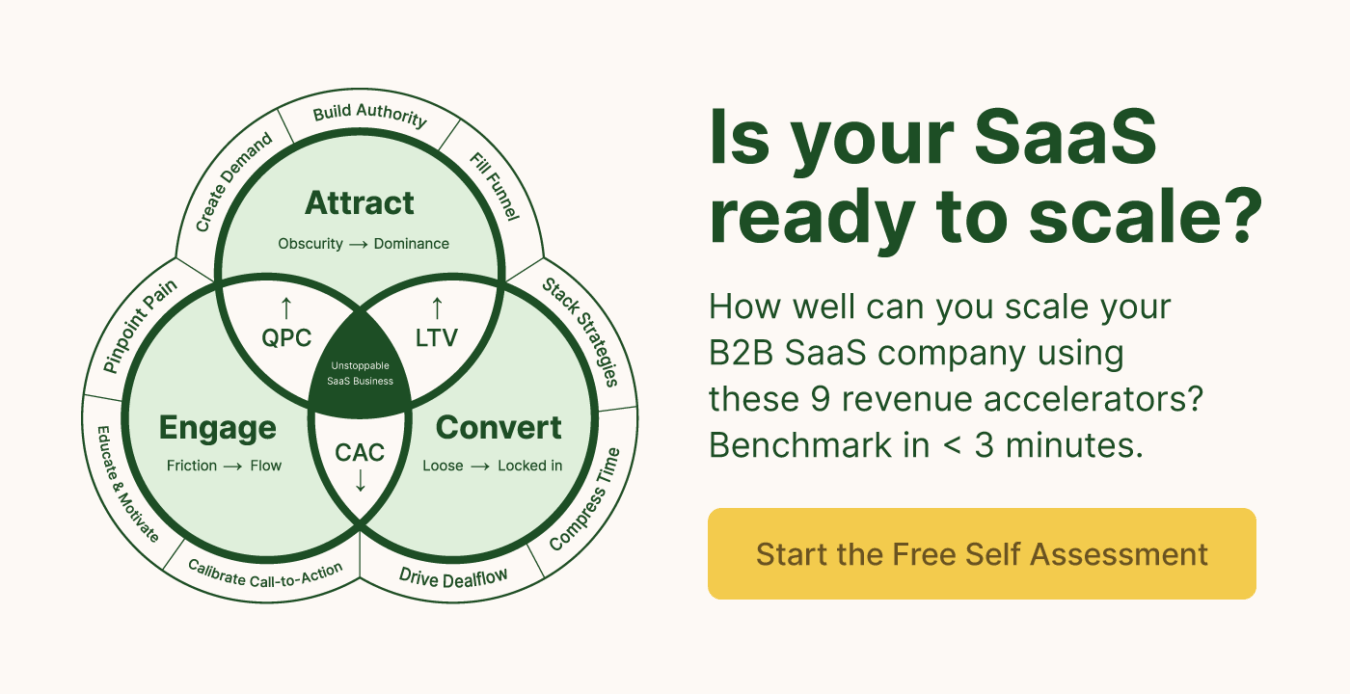Your Product Is the Marketing: How to Build a Testimonial Flywheel That Sells for You
Last updated: August 9th, 2025
Most customer quotes praise your software and convince prospects that you’re a legitimate company.
Yet testimonials rarely give prospects a reason to choose your product over a competitor’s product because they don’t explain:
- The specific pain points the product solves (and how it solves them)
- How your product is different
- Who is the right fit for your product
If you think about it, a great customer testimonial often reiterates your messaging, positioning, and tells your prospects why you’re better than other solutions in the market.
The best part? The message is also much more powerful and authentic coming from a customer.
The Problem With Most Testimonials – How They Leave Prospects With More Questions Than Answers
Most customer testimonials sound generic and leave prospects with more questions than answers.
Here are a few examples:
Sample Testimonial: “Great product that I highly recommend to my friends.”
Prospect Reaction: Okay, but why do you recommend it, and to which friends?
Sample Testimonial: “It helped our team double efficiency.”
Prospect Reaction: What specific problem did it solve that unlocked that efficiency? Because I have XYZ problem. I know solving that problem would double efficiency, but I don’t know if this product can do that.
Sample Testimonial: “Hands down the best solution for XYZ on the market!”
Prospect Reaction: Okay, but why? Is that true for my company, or is your company different from mine?
Instead of gathering generic testimonials that often gather dust in a hidden page on your website, we use a customer testimonial flywheel to collect effective customer testimonials that provide authentic proof for specific customer pain points and objections and place them in the most opportune moments throughout the buyer journey.
This level of specificity ensures each customer testimonial is proof to back specific claims your marketing or SDRs may make.
The Five-Stage Testimonial Flywheel Framework
Below we’ll discuss the five stage testimonial flywheel framework we’ve developed.
We’ll also highlight how each step of the customer testimonial framework drives impact compared to the generic approach of collecting and distributing customer testimonials at random.
Stage 1: Capture – Harvest Wins in Real Time
Many customer testimonials are collected at random.
You might look for the biggest customer or the one you have the most contact with and ask them for a customer testimonial as needed.
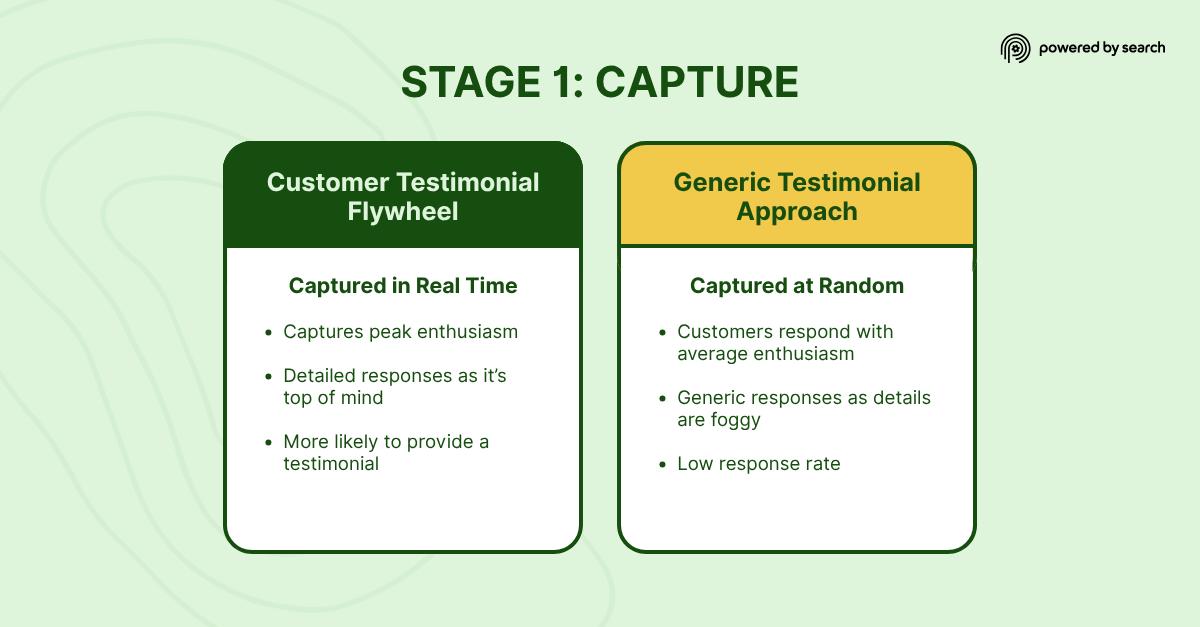
We’ve found that you’re more likely to get higher quality testimonials if you collect them in the moment the customer experiences the value.
Not only are customers more willing to give a testimonial in the moment they’re experiencing value, but they can also clearly (and effusively) articulate the pain relief your product has provided.
This results in a customer testimonial that is much more specific and can be used as proof to support specific benefit claims.
Here are a few of the triggers we use to capture testimonials:
- Milestone Moment: 30/60/90‑day success metrics hit
- Usage Spike: Feature adoption jumps +25% week‑over‑week
- Support Delight: Ticket solved > 2 × faster than SLA
- NPS > 8: Promoter leaves glowing comment
Tactically, here’s how we actually capture these testimonials:
- Quick Zoom call (< 10 min) with a calibrated question bank:
“What worried you before partnering with us?”
“How is life different 90 days later?” - Async Loom request, no fancy production, just authenticity
- Slack/Teams screenshot capture (use CloudApp or Droplr)
- Gong snippet of a renewal/upsell call
Stage 2: Tag – Structure Your Proof Library
If you have a lot of customer testimonials, your SDRs probably don’t know where they are or which pain points they have customer testimonials for.
Even if they do know where the customer testimonials are, they probably can’t quickly pull up a relevant testimonial in seconds on a sales call.

To solve this problem, we make every quote searchable and deployment‑ready by creating an Airtable (or Notion DB) with these fields:
- ICP Segment (FinTech, Cybersecurity, Vertical SaaS)
- Role (VP Marketing, RevOps, Founders
- Pain Point (High CAC, Agency Burnout, Attribution Chaos)
- Format (Text, Video, Screenshot, Audio)
With tags in place, your Growth, SDR, and CS teams can filter “Video + VP Marketing + Cybersecurity” in seconds.
This level of organization may seem unimportant, but it can be the difference between getting a prospect to convert on a demo and dragging out the sales cycle.
Stage 3: Inject – Put Proof Wherever Friction Happens
The objections a prospect experiences change as they progress throughout the buyer journey.
For example, at the beginning of the buyer journey, they might be asking questions like:
- How do I solve XYZ problem?
- What are the different products available for this pain point?

At the bottom of the funnel, the questions a prospect might ask include:
- How is this product different from XYZ competitor?
- What is your pricing model, and what’s included in each tier?
This is why the “one size fits all” testimonial doesn’t work.
Instead, we map out the buyer journey and then place testimonials that support specific claims to each objection.
Here’s an example of how we map this out:
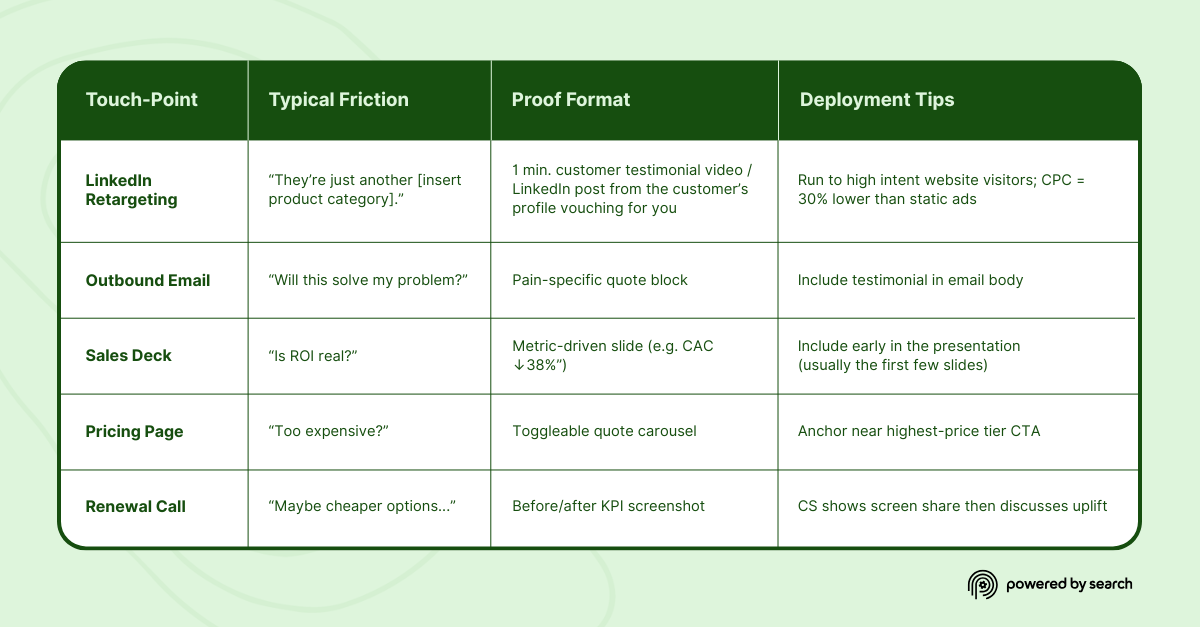
In fact, we’re even implementing this in our marketing strategy.
For example, several of our clients post testimonials on LinkedIn explaining how they use our service to grow and why they selected us as a partner. Once it gains enough traction organically, we then promote this as a thought leader ad to our prospects in our ABM list to build trust early in the buying journey and proactively address any potential objections.

Stage 4: Expand – Turn Praise into Upsell Fuel
Testimonials are often used to earn new revenue, but it’s uncommon for teams to use them to upsell existing customers.
Yet it’s often more profitable to upsell an existing customer than convert a brand new customer.
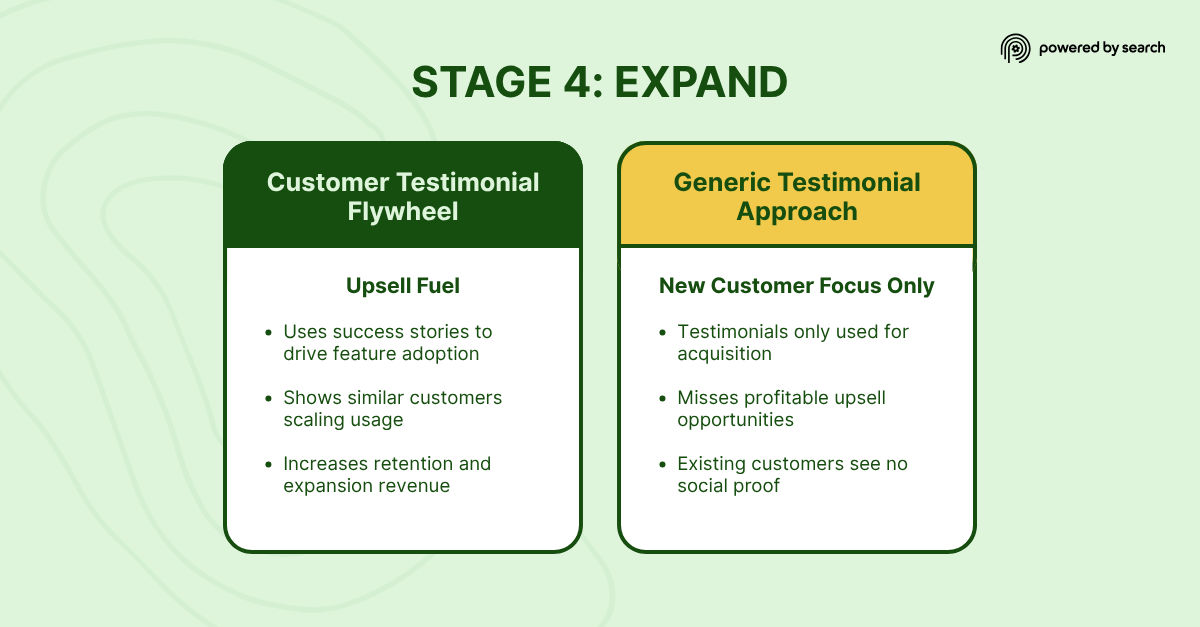
For example, Clay launched a feature called “Custom Signals” and their CEO published a LinkedIn post illustrating how other brands like Cursor, Rippling, Density, and Amplitude used that particular feature. The feature launch post emphasized the success stories of large, well known brands that used the feature, talked specifically about how they used it, and the results they got from it.
As a customer who was on a lower tier plan, seeing multiple versions of this post on my feed piqued my curiosity and made me want to upgrade to give this feature a shot.
In addition to creating LinkedIn posts, here are a few other ways you can use testimonials to upsell existing customers:
- In‑app alerts: “Teams like yours increased retention 12% after upgrading to Predictive Insights.”
- QBR decks: Show how similar accounts scaled usage + revenue
- Customer newsletter: Feature a monthly “Win of the Month” story pointing to add‑on feature guides
Stage 5: Reactivate – Win Back Dormant or Churned Accounts
Most SaaS companies have a reactivation email sequence to win back churned customers, yet these emails are usually just reminders.
However, reminder emails don’t really give users any reason to sign up for your product.
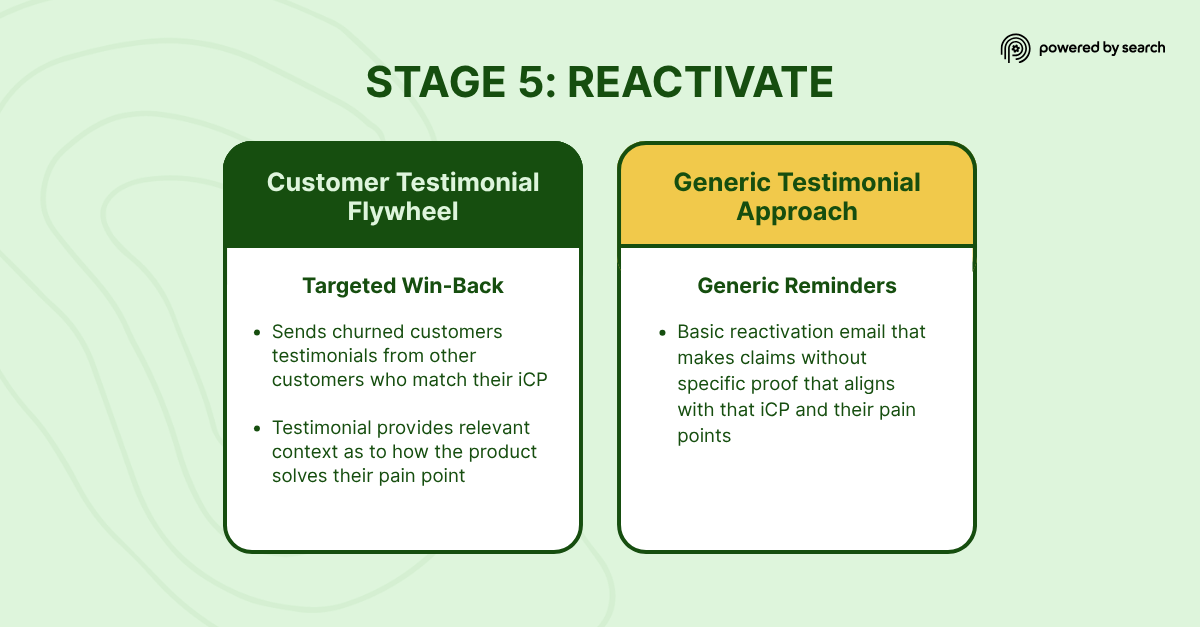
Instead, we first segment churned accounts by churn reason (e.g., Price, Champion Left, Feature Gap).
Then, we match a testimonial illustrating how other similar customers derived value from the product.
Finally, we deliver the testimonial to these audiences via LinkedIn ads and monitor their performance. And for better impact we always recommend you layer these customer testimonial ads on top of your reactivation emails for dead leads.
Get More Help Building Your Testimonial Flywheel
This is the playbook we use to build the testimonial flywheel, but that isn’t to say that execution is easy.
For example, figuring out where to inject testimonials in your marketing funnel and getting buy-in from your team can be challenging.If you want more assistance building your testimonial flywheel and improving your marketing, come talk to us. We’ll audit your current testimonials and map them to your buyer journey so you start closing more deals in 30 days.
What you should do now
Whenever you’re ready…here are 4 ways we can help you grow your B2B software or technology business:
- Claim your Free Marketing Plan. If you’d like to work with us to turn your website into your best demo and trial acquisition platform, claim your FREE Marketing Plan. One of our growth experts will understand your current demand generation situation, and then suggest practical digital marketing strategies to hit your pipeline targets with certainty and predictability.
- If you’d like to learn the exact demand strategies we use for free, go to our blog or visit our resources section, where you can download guides, calculators, and templates we use for our most successful clients.
- If you’d like to work with other experts on our team or learn why we have off the charts team member satisfaction score, then see our Careers page.
- If you know another marketer who’d enjoy reading this page, share it with them via email, Linkedin, Twitter, or Facebook.
